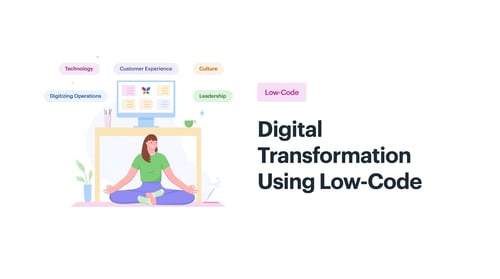Introduction
Digital transformation is no longer optional for organizations seeking to stay competitive in a rapidly evolving business landscape. Low-code platforms have emerged as a critical enabler of this transformation, allowing businesses to streamline processes, enhance agility, and deliver innovative solutions with minimal coding efforts. By adopting low-code, enterprises can bridge the gap between technical capabilities and business needs, making the switch effective and essential.
In most cases, a digital transformation necessitates that an organization:
- Create new apps, connections, and advanced analytics;
- update cloud-based systems;
- create customer-facing mobile apps;
- And automation of workflows
Importance of Low-Code in Digital Transformation
- Accelerated Development: Low-code platforms reduce development time significantly, enabling businesses to launch applications faster.
- Improved Collaboration: Non-technical teams can collaborate with IT to develop solutions, fostering innovation and alignment.
- Cost-Effectiveness: Businesses can reduce development costs by minimizing the need for extensive coding.
- Scalability: Low-code solutions support business growth without requiring heavy infrastructure investment.
- Resilience: Quick adaptability to market changes and technological advancements ensures business resilience.
Objectives of digital transformation
The use of digital technologies in all aspects of a company to improve how they run is known as digital transformation. To each company, this may imply something rather different. Whatever it means, digital transformation needs complete corporate buy-in. There is a better likelihood that digital transformation will accomplish if personnel are focused on the fundamental goal of the transition. The following are some of the most important goals of digital transformation:
1. To enhance customer service:
One of the pillars of digital transformation is service enhancement. Customers must receive better service and have their requirements addressed more quickly and completely. Income and earnings will increase as a result of this. Digital transformation aids in the integration of business and IT teams. This frees up time for expert developers to focus on code, which requires human ability. It also allows corporate users to construct their own apps, saving developers a significant amount of time, which has a positive influence on the organization. As a result, businesses operate more efficiently and effectively.
2. To improve internal collaboration:
Workforce collaboration is a high priority, particularly when combined with a dispersed workforce which will never come back to the office in its entirety. Employers are seeking new methods to boost productivity, and digital technology is playing a key role in assisting employees in being more productive in their core duties both inside and outside the office. Digital transformation represents a useful incentive for core business functions such as funding and human resources to move away from conventional methods and automate key areas such as billing, allowing leaders to focus on larger marketing strategies.
3. To boost efficiency:
Agile teams must swiftly develop minimal viable apps and then enhance them based on user feedback to complete these responsibilities. Microservices designs, public cloud deployments, and DevOps automation are all being adopted by IT teams. Nevertheless, conventional software development cannot keep up with the speed and scope of digital transformation, and most businesses grapple with personnel and skills necessary to develop and maintain these efforts. To meet those objectives, low-code development methods and technologies are used.
4. To mitigate shadow ITs:
With the rise of digital transformation, many business units turn to unauthorized or unsanctioned applications to meet their needs, a phenomenon known as shadow IT. While well-intentioned, shadow IT poses risks by bypassing IT governance and security protocols. Digital transformation addresses this by empowering departments with safe, approved,link low-code/no-code platforms. Organizations can support innovation without compromising security or compliance by enabling business teams to develop applications within a governed environment, aligning business needs with IT oversight.
Advantages of Low Code in Digital Transformation
- Faster Time-to-Market: Rapid development cycles enable businesses to deploy solutions in weeks rather than months.
- Reduced Dependency on IT: Empowers business users and citizen developers to create applications independently.
- Enhanced Innovation: Encourages experimentation by lowering the technical barrier to entry.
- Integration Capabilities: Seamlessly integrates with existing systems, improving operational efficiency.
- Improved User Experience: Simplifies workflows and provides intuitive interfaces for end-users.
- Flexibility and Agility: Easily adapt to evolving business needs without extensive rework.
What are the different approaches to digital transformation
| Low-Code Development |
No-code Development |
| Developers are the perfect end-users for low-code platforms. These systems need technical expertise yet allow skilled developers to work more quickly. For coders, the more effective the tools for speeding up technical development, the better. |
No-code platforms allow businesses to easily develop apps, layer customization, and add features on them. With such advanced possibilities, businesses may create their own apps without writing a single line of code, or with a little code for any optional modification. |
| With low-code, you can create a plethora of apps such as custom analytics dashboard, a complete hospital management software, etc and add custom code to extend the capabilities. You can deliver the working samples to stakeholders in days, if not hours. |
If you need a quick app to tackle a specific business or department issue but do not want to wait for IT to create and deploy it in 3-6 months, no-code is a wonderful option. For example, we can create apps such as leave management workflow, inventory monitoring, etc. |
| Most low-code platforms will be tough to learn fast if you are a complete newbie to development. But as a visual, highly abstracted, and automatized approach to software development, low-code relies on tools to produce the majority of the code base. |
No-code platforms enable us to create applications without hiring a developer, access to a large selection of pre-built templates, and ability to get an app running in a little time. |
How can Kissflow Low-code platform be a business enabler?
Situations like this occur often in organizations:
- A Field Operations staff needs to schedule fulfilment processes
- The Marketing Department needs to link customer data to specific digital marketing platforms
- Your Partner-facing internal group wants to create a PWA application that can be supported on a budget
Other strategic examples include building apps that connect to ERP, CRM, HR, and IT systems to minimize the need for data entry in various systems.
Kissflow Low-Code is a low-code platform for digitizing operations and automating processes that seeks to boost efficiency and productivity in businesses. Kissflow Low-Code allows business users to create their personal apps without having to rely on IT or experts. You need Kissflow Low-Code if you want to:
Work on process-based problems:
Every business leader in today’s fast-changing world faces the enormous task of digital transformation. Processes and the systems that support them go a long way toward delivering the digital agility required. But it’s crucial to remember that none of this would be possible without people.
Encourage employees by creating citizen developers:
Business users can become citizen developers with the help of a low-code application platform. Low-code workflows allow them to design or modify simple procedures on their own. This eliminates the need for them to contact IT to have a system recorded, allowing IT to focus on more difficult operations.
Align business and IT with each other:
Keeping all on the same page when it comes to process change is vital to success. Low-code application platforms can integrate business users with IT, helping to strengthen the relationship between departments, in addition to enabling the rise of citizen developers within the business.
Wrapping up
Accessing digital expertise, however, may be costly, and there is sometimes a scarcity of experienced coders in the pool of players. This is where low-code has a huge advantage, because it needs less technical work, allowing existing employees to build or modify procedures.
One of the most difficult challenges for many IT representatives is figuring out how to place more information at the network’s edge while keeping that data secure. This is becoming a more difficult undertaking, requiring better regulation of access, data compliance, and attack protection. Hence, as a rule of thumb, Kissflow Low-Code always makes security and collaboration a priority before anything else.
Don’t believe in us. Get in touch with us to know more about how you can get started with your digital transformation journey today.













